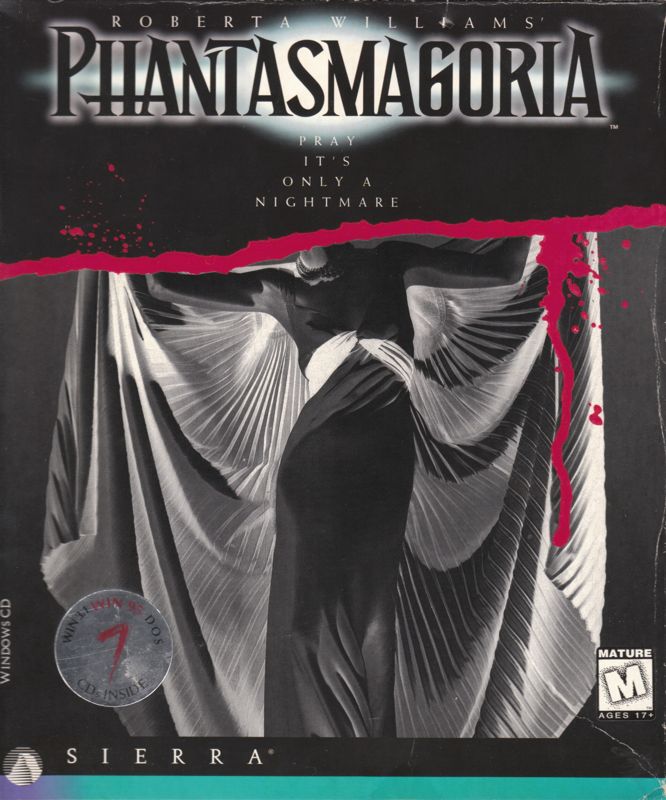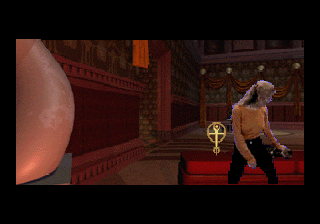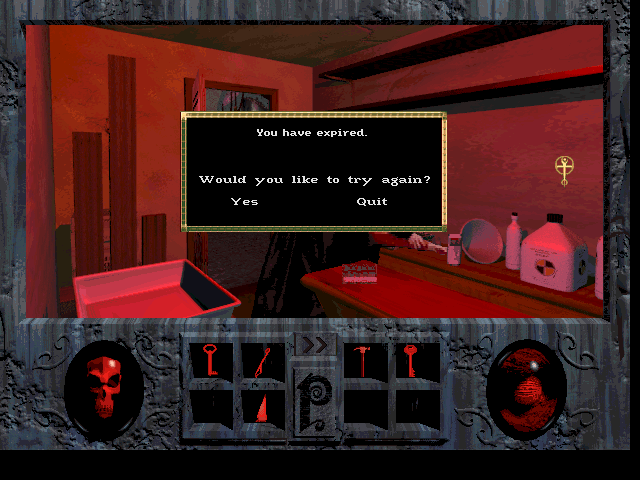Retro Replay Review
Gameplay
Roberta Williams’ Phantasmagoria delivers a primarily point-and-click adventure experience that leans heavily on full-motion video (FMV) sequences to drive its narrative. Players guide Adrienne Delaney—digitized against richly detailed pre-rendered backdrops—through a sprawling, sinister mansion. Exploration hinges on inspecting rooms, collecting items and adding them to an on-screen inventory, then using those items to unlock new areas or advance the story. The interface is straightforward, with mouse-driven navigation and context-sensitive cursors that clearly indicate usable objects.
While traditional puzzle-solving elements are present, the game reduces their complexity compared to other Sierra titles. Most challenges center on finding the right item for a specific environment rather than intricate logic puzzles. This focus makes the flow more cinematic but may feel light for adventure veterans. To assist players, Phantasmagoria includes a “hintkeeper”—a talking skull that dispenses guidance when prompted. Combined with the ability to begin from any of the seven chapters, these features ease potential frustration.
The pacing strikes a balance between methodical exploration and sudden bursts of horror. Frequent FMV interludes punctuate gameplay, delivering exposition and jump scares in equal measure. Though some chapters lean more on atmosphere than action, the overall progression maintains interest. The straightforward mechanics, coupled with built-in hints, ensure that newcomers to the genre can stay immersed rather than stalled.
Graphics
At its release, Phantasmagoria’s graphics were groundbreaking in horror adventure. The game pairs live-action video of actors (notably Adrienne herself) with pre-rendered, painted backdrops, creating a photorealistic yet uncanny atmosphere. While modern players may notice pixelation or color banding, the detailed environments—creaking floorboards, dusty chandeliers and flickering candles—still convey an oppressive, haunted mansion aesthetic.
FMV cutscenes stand out as the game’s visual centerpiece. The full-screen sequences employ makeup, practical effects and early digital compositing to portray nightmares, spectral apparitions and gruesome violence. Though some effects appear dated by today’s standards, they remain evocative, especially when paired with dramatic lighting and unsettling camera angles. Strategic use of shadow and color underscores moments of genuine dread.
Visually, the mansion itself becomes a character. From the decaying walls of the servants’ quarters to the ornate but ominous ballroom, each room is rendered with meticulous care. This attention to detail fosters a tangible sense of place. For players who appreciate atmospheric design and practical horror effects, Phantasmagoria’s graphics still hold up as an ambitious achievement of early ’90s interactive storytelling.
Story
The narrative centers on Adrienne Delaney, an aspiring writer who moves into a remote Maine mansion with her photographer husband, Donald. Almost immediately, Adrienne is plagued by horrifying nightmares and eerie encounters—muttering voices through the walls, ghostly figures emerging in mirrors and unexplained blood stains. As these supernatural events escalate, Donald’s behavior grows erratic and menacing, hinting that the house itself is feeding on his psyche.
Structured into seven chapters, the story unfolds in measured beats. Each chapter opens with an atmospheric FMV that sets the tone—whether a glimpse of the mansion’s tragic history or a chilling prelude to the horrors to come. Players piece together the house’s dark past through journals, newspaper clippings and overheard conversations, culminating in revelations about murder, madness and a malevolent force trapped within the walls.
Character development is conveyed primarily through Adrienne’s reactions and the environmental storytelling. Although Donald remains an off-screen presence for much of the game, his gradual descent into cruelty provides emotional stakes. Adrienne’s internal monologues—voiced during pivotal FMV moments—lend depth to her terror and determination. The narrative’s blend of gothic horror and psychological suspense ensures that each new discovery feels earned.
Overall Experience
Phantasmagoria stands as a landmark in interactive horror, marrying Sierra’s adventure design with cinematic FMV to craft a uniquely immersive thriller. The simplified puzzles and robust hint system allow the story to take center stage, while meticulously crafted visuals and soundscapes amplify the tension. Though modern players may find the graphics dated and the pace deliberate, the game’s ambitious scope and unwavering commitment to atmosphere make it a worthwhile journey into the macabre.
This title will most appeal to fans of classic adventure games, FMV enthusiasts and horror aficionados seeking a narrative-driven experience. The mansion’s secrets, coupled with the unsettling transformation of Adrienne’s husband, deliver a haunting ride that rewards exploration and pays off in dramatic cutscenes. Casual players may appreciate the forgiving chapter select and hintkeeper, though those craving fast-paced action may find the game’s measured pacing less engaging.
Overall, Roberta Williams’ Phantasmagoria remains a fascinating time capsule of early ’90s interactive horror. Its combination of live-action footage, richly detailed environments and psychological storytelling creates a singular mood—one that continues to unsettle and intrigue. For anyone curious about the origins of narrative-driven scare adventures, this game offers a memorable, if occasionally dated, plunge into the supernatural.
 Retro Replay Retro Replay gaming reviews, news, emulation, geek stuff and more!
Retro Replay Retro Replay gaming reviews, news, emulation, geek stuff and more!









Reviews
There are no reviews yet.